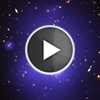CXC Home | Search | Help | Image Use Policy | Latest Images | Privacy | Accessibility | Glossary | Q&A
Tour of IDCS J1426.5+3508
Quicktime MPEG With closed-captions (at YouTube)
How quickly can galaxy clusters — the Universe's largest objects held together by gravity — form? Astronomers don't know exactly, but by examining some of these mega-structures in the early Universe they can begin to figure it out. The galaxy cluster called IDCS J1426.5+3508 is one that helps astronomers do just that. This galaxy cluster was first discovered by the Spitzer Space Telescope in 2012. Follow-on observations by the Hubble Space Telescope and the Keck Observatory in Hawaii pinpointed its distance. Radio data from the CARMA telescope array in California then suggested this galaxy cluster was very massive. New X-ray data from Chandra confirmed that IDCS J1426 was indeed enormous, weighing in at a whopping 500 trillion times the mass of our Sun. This is the most massive galaxy cluster discovered at this epoch in the early Universe - just 3.8 billion light years after the Big Bang. While this sounds like an incredibly long time, it is relatively quick in terms of forming something the size of IDCS J1426. By studying this galaxy cluster, astronomers hope to better understand how these colossal objects formed and evolved in the young Universe.
[Runtime: 02:29]
Quicktime MPEG With closed-captions (at YouTube)
How quickly can galaxy clusters — the Universe's largest objects held together by gravity — form? Astronomers don't know exactly, but by examining some of these mega-structures in the early Universe they can begin to figure it out. The galaxy cluster called IDCS J1426.5+3508 is one that helps astronomers do just that. This galaxy cluster was first discovered by the Spitzer Space Telescope in 2012. Follow-on observations by the Hubble Space Telescope and the Keck Observatory in Hawaii pinpointed its distance. Radio data from the CARMA telescope array in California then suggested this galaxy cluster was very massive. New X-ray data from Chandra confirmed that IDCS J1426 was indeed enormous, weighing in at a whopping 500 trillion times the mass of our Sun. This is the most massive galaxy cluster discovered at this epoch in the early Universe - just 3.8 billion light years after the Big Bang. While this sounds like an incredibly long time, it is relatively quick in terms of forming something the size of IDCS J1426. By studying this galaxy cluster, astronomers hope to better understand how these colossal objects formed and evolved in the young Universe.
[Runtime: 02:29]
(Credit: NASA/CXC/A. Hobart)
Return to IDCS J1426.5+3508 (January 7, 2016)



